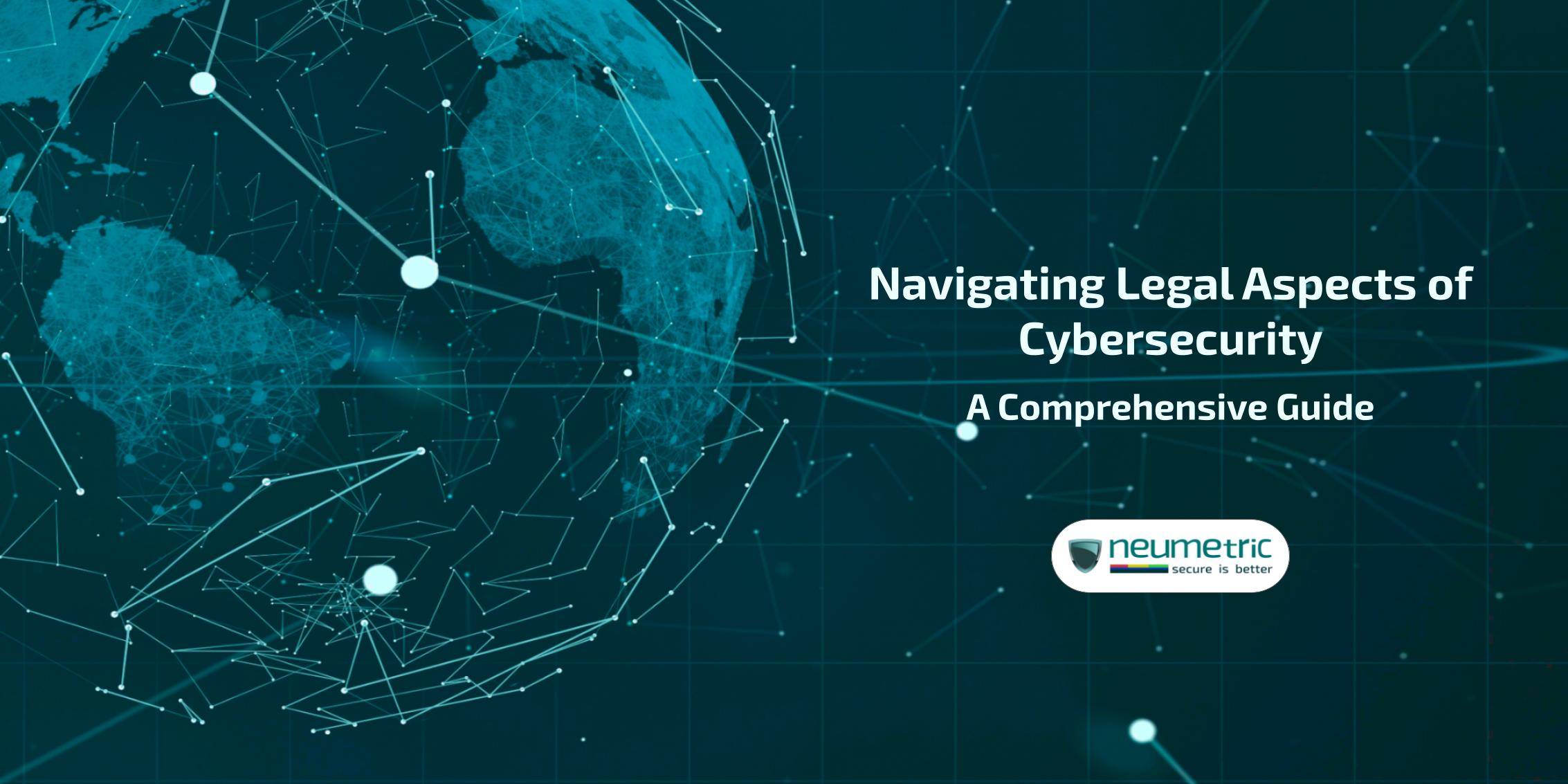Table of Contents
ToggleIntroduction
While robust technical measures are pivotal in fortifying systems against cyber threats, they’re incomplete without a comprehensive understanding of the legal implications surrounding data protection, privacy laws & compliance regulations. Legal understanding empowers organisations to navigate the complex web of regulations & standards, ensuring their operations align with the requisite legal frameworks. It not only shields businesses from potential legal pitfalls & financial penalties but also cultivates trust among consumers by demonstrating commitment to safeguarding their data & privacy.
The purpose of this comprehensive Journal is to demystify the legal aspects of cybersecurity, offering insights & guidance to professionals, businesses & individuals seeking to bolster their understanding of cybersecurity laws & regulations. It aims to serve as a roadmap through the labyrinth of legal intricacies, providing clarity on compliance requirements, liability concerns & best practices.
The scope of this Journal encompasses an extensive exploration of global & national cybersecurity laws, the interplay between cybersecurity & privacy regulations, legal implications during cybersecurity incidents, vendor management considerations & a look into emerging legal trends shaping the cybersecurity landscape. By shedding light on these critical aspects, this guide endeavours to equip readers with the knowledge necessary to navigate the complex intersection of law & cybersecurity effectively.
Cybersecurity Laws and Regulations
In today’s interconnected world, several major international cybersecurity standards serve as pillars in shaping the legal framework governing data protection & security. Standards like the General Data Protection Regulation [GDPR] in the European Union [EU] & the California Consumer Privacy Act [CCPA] in the United States [US] stand out as benchmarks in safeguarding personal data & imposing strict guidelines on data collection, storage & usage.
The GDPR, hailed as one of the most stringent data privacy laws, empowers individuals in the EU regarding their personal data, necessitating explicit consent for data processing, establishing robust data breach notification requirements & enforcing hefty fines for non-compliance.
Similarly, the CCPA, enacted in California, aims to protect consumer data rights, granting California residents control over their personal information held by businesses, mandating transparency about data collection practices & providing the right to opt-out of data selling activities.
However, the cross-border nature of data flows presents significant challenges in complying with these international standards. The GDPR, for instance, impacts businesses worldwide that handle EU citizens’ data, necessitating compliance irrespective of their physical location. These cross-border implications create compliance challenges, especially for multinational corporations navigating diverse legal frameworks.
National Cybersecurity Laws
On a national level, countries worldwide have formulated specific cybersecurity laws tailored to their unique socio-economic & geopolitical landscapes. The United States, the European Union, China & various other nations have enacted comprehensive cybersecurity regulations to address emerging threats & protect critical infrastructure.
The United States boasts a multi-layered approach to cybersecurity regulation, with sector-specific laws such as the Health Insurance Portability & Accountability Act [HIPAA] for healthcare data & the Gramm-Leach-Bliley Act [GLBA] for financial institutions. Additionally, laws like the Cybersecurity Information Sharing Act [CISA] aim to enhance information sharing between private & public sectors to mitigate cyber threats.
In the European Union, apart from the GDPR, the Network & Information Security [NIS] Directive sets out security & reporting obligations for critical infrastructure operators & digital service providers, bolstering cybersecurity preparedness across member states.
China has also established stringent cybersecurity laws, such as the Cybersecurity Law, emphasising data localization requirements, stringent data protection measures & strict controls over cross-border data transfers.
Despite variances among these national cybersecurity laws, certain commonalities exist, such as the emphasis on protecting critical infrastructure, fostering information sharing & imposing penalties for non-compliance. However, navigating these variances demands a nuanced understanding of each jurisdiction’s specific requirements. Understanding the nuances & commonalities among these global & national cybersecurity laws is pivotal for organisations operating in multiple jurisdictions to ensure compliance while fortifying their security posture in an ever-evolving digital landscape.
Understanding Legal Liability in Cybersecurity
Identifying Stakeholders & Their Responsibilities
- Company Executives & Their Accountability: Company executives, including CEOs, CIOs & CISOs, bear a substantial responsibility for cybersecurity within their organisations. Beyond merely delegating tasks, they’re ultimately accountable for establishing a culture of cybersecurity, ensuring adequate resources & support & championing compliance with relevant laws & regulations. Their role extends to risk assessment, resource allocation & setting the tone for the organisation’s cybersecurity posture.
- Legal Obligations of IT & Security Teams: IT & security teams play a pivotal role in implementing cybersecurity measures & safeguarding sensitive information. They are responsible for designing & maintaining robust security protocols, responding promptly to threats & ensuring compliance with applicable laws & industry standards. Additionally, these teams must stay abreast of evolving threats & constantly update security measures to mitigate risks effectively.
Implications of Non-compliance
- Fines, Penalties & Legal Ramifications: Non-compliance with cybersecurity laws & regulations can result in severe consequences. Authorities can impose significant fines & penalties on organisations failing to adhere to prescribed standards. For instance, under the GDPR, fines can reach up to twenty (20) million Euros or four percent (4%) of the company’s global turnover, whichever is higher, for serious infringements. Similarly, other regulations stipulate substantial penalties for non-compliance, varying based on the severity & scope of the violation.
- Reputation & Business Impact: Beyond monetary penalties, the fallout from non-compliance can severely damage a company’s reputation & business operations. Breaches resulting from lax cybersecurity measures can erode consumer trust, leading to a loss of customers & tarnishing the brand’s image. The costs associated with restoring trust & recovering from a damaged reputation far exceed the immediate financial penalties.
Moreover, breaches can disrupt business operations, leading to downtime, loss of productivity & potential legal actions from affected parties. Addressing these consequences demands substantial resources & can have a lasting impact on the company’s bottom line & future prospects.
Understanding the stakes involved in legal liability within cybersecurity is crucial for stakeholders at all levels of an organisation. It underscores the importance of proactive measures, robust compliance frameworks & a holistic approach to cybersecurity that goes beyond technical solutions to encompass legal considerations. Prioritising compliance not only mitigates legal risks but also safeguards the company’s reputation & sustains its operations in an increasingly digital & regulatory landscape.
Cybersecurity and Privacy Laws
Interplay between Cybersecurity & Data Privacy
- Data Protection Regulations & Cybersecurity Practices: Data protection regulations, such as the GDPR & CCPA, emphasise securing personal data through robust cybersecurity measures. These laws mandate specific security protocols, encryption standards & data access controls to safeguard sensitive information from unauthorised access or breaches. Cybersecurity practices are, therefore, integral in complying with data protection regulations, ensuring that data remains confidential, integral & available.
- Balancing Security Measures with Privacy Rights: Balancing security measures with privacy rights is a delicate task. While stringent security measures are crucial for safeguarding data, they must not infringe upon individuals’ privacy rights. This necessitates implementing security measures that protect data without compromising the fundamental rights to privacy. Striking this balance requires a nuanced approach, where organisations deploy necessary security measures while respecting users’ rights to control their personal information.
Legal Considerations for Handling Sensitive Information
- Consent, Transparency & User Rights: Under various privacy laws, obtaining explicit consent from individuals before collecting or processing their data is paramount. This involves transparently communicating the purposes for data collection, ensuring users understand how their information will be used & providing them with options to manage their data. Individuals have the right to access, rectify & erase their data, emphasising the importance of organisations respecting these rights & providing avenues for users to exercise control over their information.
- Data Breach Notifications & Legal Reporting Requirements: In the event of a data breach, legal obligations mandate organisations to promptly notify affected individuals & relevant authorities. Data breach notifications must include details about the nature of the breach, the type of data compromised & the measures taken to mitigate the impact. Failure to comply with these reporting requirements can lead to severe penalties & further damage to an organisation’s reputation.
Navigating the intersection of cybersecurity & privacy laws requires a holistic approach that intertwines robust security measures with a deep understanding of individuals’ privacy rights. Organisations must prioritise both aspects, implementing security practices that not only protect data but also respect & uphold individuals’ privacy, ensuring compliance with evolving legal frameworks. By aligning cybersecurity practices with privacy regulations, organisations can establish trust with their users while mitigating legal risks associated with mishandling sensitive information.
Cybersecurity Incident Response and Legal Strategies
Developing a Robust Incident Response Plan
- Legal Components in Incident Response Planning: An effective incident response plan encompasses legal considerations to ensure compliance & mitigate risks. This involves outlining procedures for breach notification, adhering to regulatory reporting requirements & understanding the legal implications specific to different types of incidents. This plan should detail how legal requirements will be met, including data breach notifications to authorities & affected individuals within specified time frames.
- Collaboration between Legal & Technical Teams: Effective incident response demands seamless collaboration between legal & technical teams. Legal expertise is crucial in interpreting regulatory obligations & advising on the legal implications of various response actions. Collaborating early & proactively ensures that technical solutions align with legal requirements, minimising legal risks while responding promptly & effectively to incidents.
Legal Challenges & Best Practices During & After a Breach
- Preserving Evidence & Managing Forensics: Preserving evidence after a breach is vital for potential legal proceedings & understanding the extent of the incident. Legal teams play a crucial role in guiding the collection & preservation of digital evidence, ensuring it complies with legal standards. Managing forensic investigations in line with legal best practices helps maintain the integrity of evidence & supports potential legal actions or regulatory inquiries.
- Post-Incident Legal Obligations & Remediation: Following a cybersecurity incident, organisations face various legal obligations & remediation efforts. This includes fulfilling data breach notification requirements, which often have strict timelines & specific content requirements. Organisations must also engage in remediation activities to address vulnerabilities, mitigate future risks & comply with any legal mandates issued as a result of the breach.
Navigating legal challenges during & after a cybersecurity incident demands a proactive approach, with legal & technical teams working hand in hand. By integrating legal strategies into incident response planning & execution, organisations can effectively manage the aftermath of a breach, minimise legal liabilities & maintain compliance with regulatory frameworks. This collaborative approach ensures a comprehensive & lawful response to cybersecurity incidents, protecting the organisation’s interests & stakeholders’ rights.
Cybersecurity Contracts and Vendor Management
Importance of Clear & Comprehensive Contracts
- Contracts with Service Providers & Third-Party Vendors: Clear & comprehensive contracts with service providers & third-party vendors are fundamental in establishing legal frameworks that safeguard your organisation’s interests. These contracts should explicitly outline the scope of services, data handling procedures, confidentiality agreements & the allocation of responsibilities regarding cybersecurity measures.
- Clauses for Security Standards & Incident Response Protocols: Including clauses that outline security standards & incident response protocols within contracts is essential. These clauses should specify the cybersecurity measures expected from vendors, such as encryption protocols, data protection standards & incident reporting procedures. Additionally, contracts should delineate the steps vendors must take in the event of a cybersecurity incident, ensuring a coordinated & efficient response to mitigate potential damages.
Legal Aspects of Vendor Risk Management
- Due Diligence & Compliance Assessments: Vendor risk management involves conducting due diligence & compliance assessments to evaluate a vendor’s cybersecurity practices & ensure they align with your organisation’s standards & legal requirements. This process involves scrutinising the vendor’s security protocols, past security incidents, compliance history & their ability to meet contractual obligations regarding cybersecurity.
- Mitigating Legal Risks in Vendor Relationships: Mitigating legal risks in vendor relationships requires proactive measures. This involves setting clear expectations through contracts, ongoing monitoring of vendor compliance & implementing risk mitigation strategies. Establishing robust vendor risk management practices minimises legal risks stemming from potential breaches, regulatory non-compliance or contractual disagreements, thus safeguarding the organisation’s interests.
Managing vendor relationships from a legal standpoint demands meticulous attention to detail & a proactive approach to mitigate potential risks. By establishing clear contractual terms, ensuring compliance through due diligence & continuously monitoring vendor activities, organisations can navigate vendor relationships effectively while minimising legal liabilities & ensuring the security of their operations & data.
Conclusion
The intersection of law & cybersecurity is not merely about implementing technical solutions but also about navigating complex legal frameworks to protect data, comply with regulations & mitigate risks. Recognizing the synergy between legal compliance & cybersecurity measures is crucial for fostering a secure digital environment that respects individual rights & meets regulatory standards.
Cybersecurity is a dynamic & ever-evolving field. As technologies advance & threats become more sophisticated, continuous learning & adaptation are imperative. Professionals in both legal & technical domains must stay updated with emerging threats, regulatory changes & best practices. Embracing a culture of learning, attending industry events, obtaining certifications & engaging in ongoing training programs will ensure that individuals & organisations remain agile & well-equipped to face the challenges ahead.
In conclusion, the journey through the legal aspects of cybersecurity emphasises the inseparable relationship between law & technology. By fostering collaboration, staying informed & adapting to the changing landscape, we can navigate the complex terrain of cybersecurity laws, effectively protect sensitive information & fortify our defences against evolving cyber threats. The commitment to knowledge, collaboration & adaptability is key to achieving a more secure digital future.
FAQ
Why is understanding cybersecurity laws & regulations so crucial for businesses today?
Understanding cybersecurity laws is paramount for businesses as it ensures compliance with regulations governing data protection, privacy & security. Non-compliance can lead to severe penalties, reputational damage & legal liabilities. Moreover, adhering to these laws instils trust among customers by demonstrating a commitment to safeguarding their sensitive information.
How does the collaboration between legal & technical teams benefit incident response in cybersecurity?
Collaboration between legal & technical teams during incident response is vital. Legal expertise helps interpret & navigate legal obligations, ensuring compliance with reporting requirements & guiding actions in accordance with laws & regulations. Technical teams work hand in hand with legal counterparts to implement security measures aligned with legal standards, enabling a coordinated & effective response to cybersecurity incidents.
What are the key considerations in vendor management from a legal standpoint?
Vendor management involves establishing clear & comprehensive contracts that outline security measures, incident response protocols & responsibilities. Conducting due diligence & compliance assessments of vendors is crucial to ensure they meet cybersecurity standards & regulatory requirements. By managing vendor relationships effectively from a legal perspective, organisations can mitigate legal risks & safeguard their operations & data.





